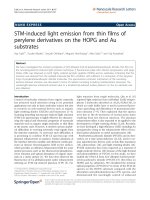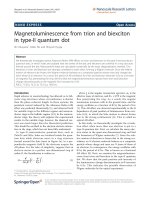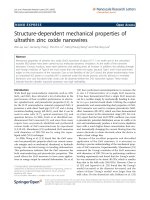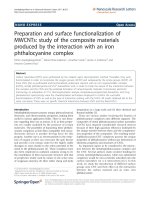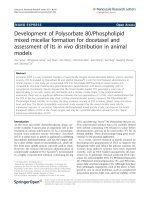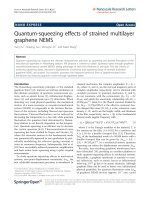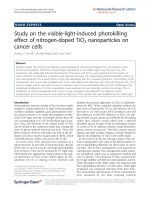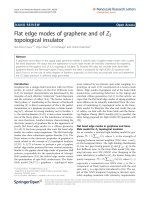Lee et al. Nanoscale Research Letters 2011, 6:352 pot
Bạn đang xem bản rút gọn của tài liệu. Xem và tải ngay bản đầy đủ của tài liệu tại đây (3.87 MB, 8 trang )
NANO EXPRESS Open Access
Structure-dependent mechanical properties of
ultrathin zinc oxide nanowires
Wen-Jay Lee
1
, Jee-Gong Chang
1
, Shin-Pon Ju
2*
, Meng-Hsiung Weng
2
and Chia-Hung Lee
2
Abstract
Mechanical properties of ultrathin zinc oxide (ZnO) nanowires of about 0.7-1.1 nm width and in the unbuckled
wurtzite (WZ) phase have been carried out by molecular dynamics simulation. As the width of the nanowire
decreases, Young’s modulus, stress-strain behavior, and yielding stress all increase. In addition, the yielding strength
and Young’s modulus of Type III are much lower than the other two types, because Type I and II have prominent
edges on the cross-section of the nanowire. Due to the flexibility of the Zn-O bond, the phase transformation from
an unbuckled WZ phase to a buckled WZ is observed under the tensile process, and this behavior is reversible.
Moreover, one- and two-atom-wide chains can be observed before the ZnO nanowires rupture. These results
indicate that the ultrathin nanowire possesses very high malleability.
Introduction
Wide band gap semiconductor materials, such as AlN,
GaN, and ZnO, have attracted a lot of attention in the
past because of their excellent performance in electro-
nic, optoelectronic, and piezoelect ric properties [1,2]. As
for the II-VI semiconductor material compound ZnO, it
possesses a wide direct band gap (3.37 eV) an d a strong
excitation binding energy (60 MeV), such that it can be
used in solar cells [3-7], optical sensitizers [8], and
quantum devices. In 2001, Feic k et al. identified one-
dimensional ZnO nanorods [9], and since then many
experts have succ essively identified and syn thesized
various kinds of ZnO nanostructures by experiment
[1,2,10 - 18]. Manoharan [19] synthesized ZnO nanowires
with diameters of 200-750 nm by using the vapor-
liquid-solid (VLS) technique.
In 2006, Wang et al. [1,2] found that the ZnO nano-
wire has piezoelectric property which can convert nanos-
cale energies such as mechanical, vibrational, or hydraulic
energy into electrical energy in bending deformation.
This performance indicates that the ZnO nanowire has
both semiconducting and piezoelectric properties. T his
result allows the ZnO nanowire to have some applica-
tions in energy output by material deformation. He et al.
[15] have perfor med nanomanipulation to measure the
in situ I-V characteristics of a single ZnO nanowire.
It has been demonstrated that a single ZnO nanowire
can be a rectifier simply by mechanically bending it, simi-
lar to a p-n junction-based diode. Utilizing the coupled
piezoelectric and semiconducting dual properties of ZnO,
ZnO nanowire was used to compose piezoelectric field-
effect transistors (PE-FET), which was then demonstrated
as a force sensor in the nanonewton range [20]. Fei et al.
[21] report that the bent ZnO PFW cantilever can create
a piezoelectric potential distribution across its width at its
root and simultaneously produce a local reverse depletion
layer with a much higher donor concentration than nor-
mal, dramatically changing the current flowing from the
source electrode to drain electrode when the device is
under a fixed voltage bias.
Because of the excellent properties and d iversified
application of the ZnO nanowire, it is necessary to
develop a precise understanding of the mechanical prop-
erty of ZnO nanowire. Experimentally, Manoharan [19]
measured the Young’ s modulus of the ZnO nanowires
with diameters of 200-750 nm by performing cantilever
bending experiments and found that the Young’s modu-
lus was estimated to be about 40 GPa, which is smaller
than that in the bulk scale (140 GPa). However, Chen et
al. [22] and Agrawal et al. [23] found that the Young’s
moduli increased as the diameter decreased, and the
values of these Young’ s moduli were larger than the
bulk value. On the theoretical side, Kulkarni et al. [24]
* Correspondence:
2
Department of Mechanical and Electro-Mechanical Engineering, Center for
Nanoscience and Nanotechnology, National Sun Yat-sen University
Kaohsiung, 804, Taiwan
Full list of author information is available at the end of the article
Lee et al. Nanoscale Research Letters 2011, 6:352
/>© 2011 Lee et a l; licensee Springe r. This is an Open Access article distributed under the terms of the Crea tive Commons Attr ibution
License (http://creativecom mons.org/licenses/by/2.0), which permits unrestricted use, distribution, and re production in any medium,
provided the original work is properly cited.
used molecular dynamics (MD) and first principles cal-
culations to investigate the phase transformation of ZnO
nanowires from wurtzite (WZ) to a graphite-like hexa-
gonal (HX) structur e under uniaxial tensile strain. Their
results show that the WZ and HX structures of ZnO
nanowires had different properties. The stress-induced
pha se transformation signifi cantly alters the modulation
of piezoelectric constant and thermal conductivity of the
nanowire. Wang et al. [25] also reported structural
transformation from WZ to HX structure for ultrathin
ZnO nanowires under un iaxial elongation and compres-
sion. Moreover, the band gap, Young’s modulus, and
Milliken charges were calculated by density functional
theory (DFT), and it was found that the band gaps of
ZnO nanowires depended on the size and geometry of
the nanowire, i.e., the WZ phase of ZnO nanowires had
a larger band gap than the HX phase. However, for
Young’s modulus of the ZnO nanowires, HX phase was
higher than the WZ phase, increasing with a decrease in
the size of ZnO naowires (HX). Wu et al. [26] found a
structure transformation by DFT calculation from the
HX phase to WZ phase as the diameter and length of
the AlN, GaN and ZnO na nowire increased. They also
justified that the phase transformation is caused by
competition between the bond energy, the Coulomb
energy,andtheenergyoriginatingfromthedipolefield
of the WZ structure. Hu et al. [27] and Wang et al. [25]
presented the mec hanical properties of ZnO nanowires
with WZ structure and nanotubes as a function of dia-
meter by using MD simulation. Their results show that
Young’s modulus of ZnO nanowire is inversely propor-
tional to the diameter of nanowire, which is a result in
agreement with Wang et al. [20]. They demonstrate that
the size-dependent elastic properties of nanowires prin-
cipally arise from the stress-induced surface stiffening.
Wang et al. [28] found a novel stress-strain relationship
with two stages of linear elastic deformation in [0001]-
oriented ZnO nanoro ds under tensile loading [28]. This
phenomenon is caused by a phase transformation from
WZ to a body-centered tetragonal structure with four-
atom rings (BCT-4 ). In addit ion, they show that the two
stages of linear elastic deformation still exist at a high
temperature of 1500 K. Dai et al. [29] found the single
atom chain structure during the tensile process. They
explain that the growth of the single atom chain results
from the bond breakage at the junction of the chain and
the amorphous bulk. Moreover, they also propose a
mechanics-based criterion for neck propagation. How-
ever, the Young’ s modulus and yielding stress of ZnO
nanowires with thickness less than 1.6 nm is much
lower than the other larger cases, which could be due to
the significant deformation in the initial structure.
Until now, the research of the mechanical properties
of ZnO nanowires with HX structure has concentrated
almost solely on the elastic property. There is still no
research discussing the d eformation mechanism in
detail. As a result, the present work uses MD simulation
for detailed discussions of the mechanical properties
(yield stress and Young’s modulus) and the deformation
behavior of ZnO nanowires under uniaxial tension.
Simulation model
In the present study, the mechanical property and defor-
mation behavior of ZnO nanowires in the HX phase are
investigated by MD simulations [30,31]. To understand
the lateral size effect of HX phase ZnO nanowires, three
ZnO nanowires were chosen as the initial systems. These
nanowires were initially in the WZ phase, and had a dia-
meter of about 0.7-1.1 nm and length of 7.2 nm, because
only ZnO nanowires with diameters less than 1.3 nm can
transform to the HX phase [25,26]. After the structural
optimization by Genetic Algorithms software module, the
ZnO nanowires transform to the HX phase. For the ten-
sile test, canonical ensemble (NVT ensemble) [30,31] is
employed in the MD simulation. We intercept in the
middle region of the optimized nanowires, because the
structure of both ends is somewhat nucleated, which
could affect the intrinsic property of the nanowire. The
details will be discussed in the first paragraph of “Results
and discussion” section. The lengths of three nanowires
are all set 5.5 nm. The atom numbers for the three nano-
wires are 364, 448, and 512. Prior to elongation, the Zn
atoms and O atoms consist of two atomic layers at both
ends of the ZnO nanowire, which are kept fixed, whereas
the remaining layers are the thermal control portion.
This relaxation process was used to eliminate the internal
stresses. For the thermal control portion, the Nosè-
Hoover method is adopted to ensure a constant system
temperature at 1 K throughout the elongation procedure
and the Velocity Verlet algorithm [30,31] is also emp-
loyed to calculate the trajectories of the a toms. A time
step of 1 fs was set for the time integration. In the axial
tensile process, a tension with strain rate 0.02% ps
-1
is
applied to the nanowire by applying a constant velocity
to the two fixed layers in the axial direction. To measure
the stress of the ZnO nanowire under elongation, the for-
mulation of atomic level stress [32] is employed, which
includes the kinetic and potential effects.
In the present study, the Buckingham potential of short-
range interaction and Coulomb-elec trostatic po tential of
long-range interaction are combined as the interatomic
potential to simulate the interaction between the atoms
oftheZnOnanowire,whichisshowninEquation1as
follows:
E
B
r
ij
=
q
i
q
j
r
ij
+ A
ij
exp
−
r
ij
ρ
−
C
r
6
i
j
(1)
Lee et al. Nanoscale Research Letters 2011, 6:352
/>Page 2 of 8
where A
ij
, r
ij
,andc
ij
in Equation 1 are variable para-
meters given in reference [33]. r
ij
is the distance between
i and j atoms. The first term in Equation 1 represents
the long -range Coulomb interactions between two ions,
and the second and third terms describe the overlap
repulsion between atoms and the dipole-dipole interac-
tion. The Ewald summation is employed to increase the
computational efficiency in calculations of the long-
range interaction of Coulomb force. In addition, the
Coulomb interactions are usually modeled by constant
charges for different ions. Such a model limits the possi-
bility to describe a charge redistribution at a surface. As
a result, a shell model potential for each ion connected
via a spring [33-35] needs to be employed to handle the
polarization of the oxygen ions. The total charge q of the
ion is split between a core (of charge q-Y) and a shell (of
charge Y), which are coupled by a spring constant K as
follows:
E
c−s
(δ
ij
)=
1
2
Kδ
2
ij
(2)
where δ
ij
is the core-shell distance. The potential para-
meters of the atoms of ZnO nanowire interactions
adopted in the p resent study are listed in Table 1. The
force field developed in this work is based on the intera-
tomic potential derived by Oba et al. for ZnO, from
which the potential p arameters were f itted to the RS
cubic structure [36]. These parameters have been
demonstrated such that the structural and thermody-
namic parameters including equilibrium volume, lattice
constant, isothermal bul k modulus, and its pressure
derivative at standard condition are in good agreement
with available experimental data and the latest theo reti-
cal results [33,36-38]. Therefore, the potentials could
increase the confidence level of this study.
Results and discussion
This study addresses the t ensile test of single crystalline
HX phase ZnO nanowires of different wire width along
the [0001] direction. Figure 1 shows the minimized pro-
cedure of potential energy per ZnO monomer as a func-
tion of minimization iteration, and the insets show the
corresponding structure at different minimization steps.
It is found that the energy gradually descends to
-38.9 eV. The width of the nanowires becomes thicker
and the WZ phase transforms to a HX phase after the
energy minimization. The energy of the final equilibrium
is slightly lower than that in the crystal phases (39.5-39.7
eV) [36,39] and is similar to that of ZnO in WZ, rocksalt,
and blended structures confined within silica nanopores
[39] and carbon nanotubes [40]. Note that the HX phase
is an unbuckled WZ phase. This transformation phenom-
enon has been observed by the DFT study [25,26]. To
understand the width effect on the mechanical property
and the deformation mechanism in this work, three dif-
ferent widths of ZnO nanowires are optimized by energy
minimization. Those optimized nanowire structures are
denoted as Type I, II, and III. The cross-sectional struc-
tures of the ultrathin ZnO nanowires for Type I-III with
diameters of approximately 0.7-1.1 nm are three-, two-,
and sixfold axis symmetry structures, respectively. The
cross-sectional views of the three optimized ZnO nano-
wires are presented in Figure 2, which are the most
Table 1 Parameters of Buckingham and shell model
potentials used in simulation
A (eV) r (Å) C (eVÅ
6
) K (eVÅ
-2
) Y (e)
Zn
c
-O
s
700.3 0.3372 0.0
O
s
-O
s
22764.0 0.149 27.879
O
c
-O
s
74.92 -2.86902
Figure 1 Potential energy per ZnO monomer as a function of
simulation iteration for structural minimization of Type I. The
insets are the corresponding structures.
Figure 2 Cross-section views of the structurally optimized ZnO.
(a)-(c) are the snapshots of ZnO nanowires for Type I-III.
Lee et al. Nanoscale Research Letters 2011, 6:352
/>Page 3 of 8
typical growth morphologies for ZnO nanowires found in
experiments [41,42]. Compared to the average bond
length of bulk ZnO with WZ structure, the value of Type
I, II, and III are somewhat lower and are close to the
DFT calculation results of 1.978, 1.989, and 1.999 Å [25],
as shown in Table 2. Generally speaking, the ratio of the
numbers of surface atoms to th e total number of atoms
increases as the width of the nanowire decreases. The
relaxation of the surface atoms i ncreases with the pre-
compressive stress inside the nanowire [43]. Therefore, a
nanowire width of smaller than critical size leads to an
increase in the fraction of surface atoms significant
enough to allow for the phase transformation to occur.
For clearly discussing the detail of the deformation
behavior, a central region and prominent edge are
defined for Type I and II in Figure 2. The corresponding
stress-strain profiles for the tensile process of different
types of nanowires are shown in Figure 3. It is observed
that as the wire width decreases, the maximum stress
and the slope of stress-strain curve increase. Clearly, the
both are much larger for Type I and II than for Type
III. In th e first stage, the stress increases linearly with
slight fluctuation until the yielding occurs at yielding
strain. The Young’s modulus can be determined from
the results of tensile test for the strain of 2%, using lin-
ear regression. The calculated results of Young’smodu-
lus for three types of nanowires are listed in Table 2,
which corresponding to Wang et al.’s work [25] as listed
inTable2.Thisshowsthatthesmallertheareaofthe
cross-section, the greater the incre ase in the Young’s
modulus and the yielding stress. The variation tendency
of the mechanical property as a function of width of
ZnO nanowires has b een verified by Kulkarni et al. [44]
and Wang et al. [25]. At strain larger than the yielding
strain, as shown in Figure 3, it is observed that the ten-
dency of Type II and III are similar, both possessing
twodifferentstagesIIandIII.AtstageII,thestress-
strain curve shows zigzag fluctuation from the yielding
strain to the strain of approximately 35%. This phenom-
enon in Type II and III represents the local phase trans-
formati on, which is illustrated in Figure 4, which sho ws
the side view of the Type II ZnO n anowire under the
elongation process at diffe rent stages. It is observed that
as the strain increases, the necking region of the HX
structure gradually grows as shown in Figure 4a,b,
because some of the ZnO bond parallel t o the axis is
broken, and the local HX structure becomes a buckled
structure at the prominent edge of the cross-section of
Type II. Here, we note that the structure is clearly
buckled at the prominent edge of the cross-section of
the nanowire, while it is slightly b uckled at the central
region. In addition, the phase transformation i s gener-
ated symmetrically along the axis of nanowire, as can be
seen by the rectangles in Figure 4b. The phase transfor-
mation of the ZnO nanowire has been observed in a
loading and unloading process [24]. At stage III, the
stress increases significantly with slight fluctuation, and
is even higher than the yielding stress a t the first stage.
The slight fluctuation is due to the phase transformation
near both ends, and the significant increase in stress is
caused by the new phase as shown in F igure 4c. After
the strain passes the maximum stress, the Zn-O bond
is broken by a yielding stress of 80 GPa, as s hown in
Figure 3, and the corresponding s napshot is shown in
Table 2 Mechanical properties and bond length of ZnO
nanowire with different type of structure under
elongation test
Y (GPa) s
y
(GPa) ε
y
(%) L (Å)
Nanowire (HX)
Type I 697.919 47.516 0.113 1.973
Type II 687.401 47.617 0.108 2.008
Type III 592.880 39.033 0.094 2.018
Nanowire (HX) [25]
Type I 537.6 - - 2.068
Type II 532.6 - - 2.071
Type III 303.5 - - 2.079
Nanowire (WZ) [25]
Type I 349.1 - - 1.978
Type II 332.9 - - 1.986
Type III 164.1 - - 1.989
Nanobelt (WZ) [44] 339.76 36.332 0.046 -
172.65 10.922 0.043 -
140.37 8.625 0.02 -
Bulk [46] 144 0.2 - -
0 10 20 30 40 50 60 70 80 90 100 11
0
Strain
(
%
)
0
20
40
60
80
Stress(
G
Pa)
Type I
Type II
Type III
Figure 3 Stress-strain relationship for Type I, II, and III.
Lee et al. Nanoscale Research Letters 2011, 6:352
/>Page 4 of 8
Figure 4d. With a continuing increase in strain, the
necking d eformation gradually induces the nanowire to
become a two-atom-wide chain in the middle region as
shown in Figure 4e,f. After the strain of 108.18%, the
two-atom-wide chain is fractured as shown in Figure 4g.
For Type I, the stress-strain curve is quite d ifferent
than Type II and III. Figure 5 shows the deformation
structure at different specific strains. Compared to Type
II and III, the deformation behavior of Type I is totally
different. As can be seen in Figure 5b, unlik e the sym-
metrical phase transformation of Type II or III, th e
yielding of Type I is caused by a ZnO bond breaking, as
shown by the arrow labeled 1. The unstable Zn and O
atoms, then, lead to the first local buckling of the HX
structure at the prominent edge of the cross-section of
the Type I nanowire. Continuing, the local buckling of
the HX structure induces the bending deformation
of nanowire at the middle region and causes the second
and third local buckling deformations as shown b y
arrows labeled 2 and 3. As the strain increases, the
nucleation happens at the middle region (as illustrated
in Figure 5c), and then the deformation region in the
middle of the nanowire nucleates to a thinner HX struc-
ture (as illustrated in Figure 5d) until a strain of 21.5%.
Figure 4 Atomic configurations of Type II under uniaxial loading. (a)-(g) show the corresponding snapshots of Type II at strain of 11.10%,
34.60%, 61.00%, 65.85%, 78.60%, 105.7%, and 108.18%.
Lee et al. Nanoscale Research Letters 2011, 6:352
/>Page 5 of 8
Aft er the strain of 21.5%, the local HX structure gradu-
ally becomes a buckled structure. The buckled structure
gradually extends to include the entire nanowire until a
strain of 73.45%, as depicted in Figure 5e. Therefore, the
stress-strain curve appears to show a significant zigzag
fluctuation. After a strain of 73.45%, the middle region,
marked by an arrow, starts to form the single atom
chain. During the single atom chain growth, the buckled
structure at both sides of the nanowire gradually relaxes
and is restored to the original HX structure. The clear
single atom chain bridged be tween two tubula r tips is
observed as shown in Figure 5f. Up until strain of 125%,
the single atom chain is still not fractured.
Comparing Types I-III, although the tendenci es of t he
stress-strain curve of Type II and III are similar, the
maximum strength of Type III is much lower than Type
I and II. This is because the cross-section structure of
Type III does not have any prominent edge, and there-
fore a lower stress. In addition, the phase transformation
of Type III is generated on the whole ZnO nanowire
uniformly as shown in Figure 6. This can clearly seen by
the different cross-section side views of Type III in
Figure 6b,c. As a result, tensile strength and Young’ s
modulus o f Type I and II are much higher than that of
Type III.
We note that two stages of linear elastic deformation
were observed in the tensile test of [0001]-oriented ZnO
nanorods at a temperature higher than 300 K [27].
However, the simulation result in this work shows a
three stage stress-strain curve, which could result from
the very low tempera ture, leading to the slow growth of
phase transformation in stage II. The super ductility
of the single atom chain and two atom row structures
of ZnO have been observed in [0001] ZnO nanowire
under tensile loading by Dai et al. [29], as well as the
carbon nanotube [45], and other metal na nowir es [43].
In addition, Horlait and Coasne et al. [39,40] present
the diversified atomic structure and morphology of ZnO
nanostructure confi ned in carbon nanotube and porous
silicas, discussing the effect of pore size and degree of
pore filling on the s elf-assembly structure. The singl e
atom chain, tubular structure, and both a four-atom
ring and a six-atom ring are observed. These works ver-
ify the possible structural formation in this work.
Figure 5 Atomic configurations of Type I under uniaxial loading. (a)-(f) show the corresponding snapshots of Type I at strain of 0.00%,
11.74%, 12.00%, 21.50%, 73.45%, and 100.00% respectively.
Lee et al. Nanoscale Research Letters 2011, 6:352
/>Page 6 of 8
Conclusion
Molecular dynamics si mulation s of tensile tests of ultra-
thin ZnO nanowires have been employed to study
intrinsic behavior. Three different types of ultrathin
ZnO nanowires, with diameter from 0.7 to 1.1 nm, are
simulated, with maximum tensile strength, yielding
strain, and Young’s modulus calculated. Simulated nano-
wires were of three different cross-sectional shapes,
Type I, II, and III. As the width of the nanowire
decreases, the yielding strength, yielding strain, and
Young’ s modulus increase, w hile the bond length
decreases. The yielding strength and Young’s modulus
of Type III is much lower than the other two types,
because Type I and II have the prominent edges on the
cross-section structure of the nanowire, which leads a
stronger surface tension. Observation of the deformation
mechanism shows that the HX structure of the ultrathin
nanowire under uniaxial tensile loading transforms to a
buckled structure to relax the tensile stress until the
structure is buckled throughout the nanowire. Thi s
phase transformation process is reversible, which implies
that the process is an elastic stretching process. In addi-
tion, we found that a one-atom-wide and a two-atom-
wide chain appear before the nanowires are broken for
Type I and II, respectively.
Abbreviations
DFT: density functional theory; HX: hexagonal; MD: molecular dynamics; PE-
FET: piezoelectric field-effect transistors; VLS: vapor-liquid-solid; WZ: wurtzite;
ZnO: zinc oxide.
Acknowledgements
The authors would like to thank the National Science Council of Taiwan,
under Grant No. NSC98-2221-E-110-022-MY3, National Center for High-
performance Computing, Taiwan, and National Center for Theoretical
Sciences, Taiwan, for supporting this study.
Author details
1
National Center for High-Performance Computing, No. 28, Nan-K e Third
Road, Hsin-Shi, Tainan 74147, Taiwan
2
Department of Mechanical and
Electro-Mechanical Engineering, Center for Nanoscience and
Nanotechnology, National Sun Yat-sen University Kaohsiung, 804, Taiwan
Authors’ contributions
WJ and JG participated in the data interpretation and drafted the
manuscript. SP conceived of the study, and participated in its design and
coordination. MH and CH participated in the MD programing and
performed the statistical analysis. All authors read and approved the final
manuscript.
Competing interests
The authors declare that they have no competing interests.
Received: 8 December 2010 Accepted: 20 April 2011
Published: 20 April 2011
References
1. Qin Y, Wang XD, Wang ZL: Microfibre-nanowire hybrid structure for
energy scavenging. Nature 809-U5.
2. Wang ZL, Song JH: Piezoelectric nanogenerators based on zinc oxide
nanowire arrays. Science 2006, 312:242-246.
3. Keis K, Magnusson E, Lindstrom H, Lindquist SE, Hagfeldt A: A 5% efficient
photo electrochemical solar cell based on nanostructured ZnO
electrodes. Sol Energy Mater Sol Cells 2002, 73:51-58.
4. Touskova J, Kindl D, Tousek J: Preparation and characterization of CdS/
CdTe thin film solar cells. Thin Solid Films 1997, 293:272-276.
5. Chou HC, Rohatgi A, Jokerst NM, Kamra S, Stock SR, Lowrie SL, Ahrenkiel RK,
Levi DH: Approach toward high efficiency CdTe/CdS heterojunction solar
cells. Mater Chem Phys 1996, 43:178-182.
Figure 6 Atomic configurations of Type I under uniaxial loading. (a) and (b)-(c) show the corresponding snapshots and its cross-section side
views of Type I at strain of 33.00%.
Lee et al. Nanoscale Research Letters 2011, 6:352
/>Page 7 of 8
6. Ferekides C, Britt J: CdTe solar cells with efficiencies over 15%. Sol Energy
Mater Sol Cells 1994, 35:255-262.
7. Niemegeers A, Burgelman M: Effects of the Au/CdTe back contact on IV
and CV characteristics of Au/CdTe/CdS/TCO solar cells. J Appl Phys 1997,
81:2881-2886.
8. Sebastian PJ, Ocampo M: A photodetector based on ZnCdS nanoparticles
in a CdS matrix formed by screen printing and sintering of CdS and
ZnCl2. Sol Energy Mater Sol Cells 1996, 44:1-10.
9. Huang MH, Mao S, Feick H, Yan HQ, Wu YY, Kind H, Weber E, Russo R,
Yang PD: Room-temperature ultraviolet nanowire nanolasers. Science
2001, 292:1897-1899.
10. Kong T, Chen Y, Ye YP, Zhang K, Wang ZX, Wang XP: An amperometric
glucose biosensor based on the immobilization of glucose oxidase on
the ZnO nanotubes. Sens Actuators B Chem 2009, 138:344-350.
11. Wang RM, Xing YJ, Xu J, Yu DP: Fabrication and microstructure analysis
on zinc oxide nanotubes. New J Phys 2003, 5:115.
12. Rao BB: Zinc oxide ceramic semi-conductor gas sensor for ethanol
vapour. Mater Chem Phys 2000, 64:62-65.
13. Ozgur U, Alivov YI, Liu C, Teke A, Reshchikov MA, Dogan S, Avrutin V,
Cho SJ, Morkoc H: A comprehensive review of ZnO materials and
devices. J Appl Phys 2005, 98:041301.
14. Gao PX, Wang ZL: Nanoarchitectures of semiconducting and
piezoelectric zinc oxide. J Appl Phys 2005, 97:044304.
15. He JH, Hsin CL, Liu J, Chen LJ, Wang ZL: Piezoelectric gated diode of a
single ZnO nanowire. Adv Mater 2007, 19:781.
16. Rodriguez JA, Jirsak T, Dvorak J, Sambasivan S, Fischer D: Reaction of NO2
with Zn and ZnO: Photoemission, XANES, and density functional studies
on the formation of NO3. J Phys Chem B 2000, 104:319-328.
17. Tien LC, Sadik PW, Norton DP, Voss LF, Pearton SJ, Wang HT, Kang BS,
Ren F, Jun J, Lin J: Hydrogen sensing at room temperature with
Pt-coated ZnO thin films and nanorods. Appl Phys Lett 2005, 87:3.
18. Sberveglieri G, Groppelli S, Nelli P, Tintinelli A, Giunta G: A novel method
for the preparation of NH3 sensors based on ZnO-In thin films. Sensors
and Actuators B: Chemical 1995, 25:588-590.
19. Manoharan MP, Desai AV, Neely G, Haque MA: Synthesis and elastic
characterization of zinc oxide nanowires. Journal of Nanomaterials 2008,
2008:849745.
20. Wang XD, Zhou J, Song JH, Liu J, Xu NS, Wang ZL: Piezoelectric field
effect transistor and nanoforce sensor based on a single ZnO nanowire.
Nano Lett 2006, 6:2768-2772.
21. Fei P, Yeh PH, Zhou J, Xu S, Gao YF, Song JH, Gu YD, Huang YY, Wang ZL:
Piezoelectric Potential Gated Field-Effect Transistor Based on a Free-
Standing ZnO Wire. Nano Lett 2009, 9:3435-3439.
22. Chen CQ, Shi Y, Zhang YS, Zhu J, Yan YJ: Size dependence of Young’s
modulus in ZnO nanowires. Phys Rev Lett 2006, 96:075505.
23. Agrawal R, Peng B, Gdoutos EE, Espinosa HD: Elasticity Size Effects in ZnO
Nanowires-A Combined Experimental-Computational Approach. Nano
Lett 2008, 8:3668-3674.
24. Kulkarni AJ, Zhou M, Sarasamak K, Limpijumnong S: Novel phase
transformation in ZnO nanowires under tensile loading. Phys Rev Lett
2006, 97:105502.
25. Wang BL, Zhao JJ, Jia JM, Shi DN, Wan JG, Wang GG: Structural,
mechanical, and electronic properties of ultrathin ZnO nanowires. Appl
Phys Lett 2008, 93:021918.
26. Wu YL, Chen GD, Ye HG, Zhu YZ, Wei SH: Origin of the phase transition of
AlN, GaN, and ZnO nanowires. Appl Phys Lett 2009, 94:253101.
27. Hu J, Liu XW, Pan BC: A study of the size-dependent elastic properties of
ZnO nanowires and nanotubes. Nanotechnology 2008, 19:285710.
28. Wang J, Kulkarni AJ, Ke FJ, Bai YL, Zhou M: Novel mechanical behavior of
ZnO nanorods. Computer Methods in Applied Mechanics and Engineering
2007, 197:3182.
29. Dai L, Cheong WCD, Sow CH, Lim CT, Tan VBC: Molecular Dynamics
Simulation of ZnO Nanowires: Size Effects, Defects, and Super Ductility.
Langmuir 2009, 26:1165-1171.
30. Hoover WG: Canonical dynamics: Equilibrium phase-space distributions.
Phys Rev A 1985, 31:1695-1697.
31. Nosé S: A unified formulation of the constant temperature molecular
dynamics methods. J Chem Phys 1984, 81:511.
32. Chandra N, Namilae S, Shet C: Local elastic properties of carbon
nanotubes in the presence of Stone-Wales defects. Phys Rev B 2004,
69:094101.
33. Sun XW, Chu YD, Song T, Liu ZJ, Zhang L, Wang XG, Liu YX, Chen QF:
Application of a shell model in molecular dynamics simulation to ZnO
with zinc-blende cubic structure. Solid State Commun 2007, 142:15-19.
34. Raymand D, van Duin ACT, Baudin M, Hermannson K: A reactive force field
(ReaxFF) for zinc oxide.
Surf Sci 2008, 602:1020-1031.
35. Dick BG, Overhauser AW: Theory of the Dielectric Constants of Alkali
Halide Crystals. Phys Rev 1958, 112:90.
36. Oba F, Tanaka I, Nishitani SR, Adachi H, Slater B, Gay DH: Geometry and
electronic structure of [0001]/(1230) Σ = 7 symmetric tilt boundary in
ZnO. Philos Mag 2000, 80:1567.
37. Zaoui A, Sekkal W: Pressure-induced softening of shear modes in
wurtzite ZnO: A theoretical study. Phys Rev B 2002, 66:174106.
38. Sun XW, Liu ZJ, Chen QF, Lu HW, Song T, Wang CW: Heat capacity of ZnO
with cubic structure at high temperatures. Solid State Commun 2006,
140:219-224.
39. Coasne B, Mezy A, Pellenq RJM, Ravot D, Tedenac JC: Zinc Oxide
Nanostructures Confined in Porous Silicas. J Am Chem Soc 2009,
131:2185-2198.
40. Horlait D, Coasne B, Mezy A, Ravot D, Tedenac J-C: Molecular simulation of
zinc oxide nanostructures confined in carbon nanotubes. Mol Simul 2010,
36:1045-1058.
41. Limpijumnong S, Jungthawan S: First-principles study of the wurtzite-to-
rocksalt homogeneous transformation in ZnO: A case of a low-
transformation barrier. Phys Rev B 2004, 70:054104.
42. Yin M, Gu Y, Kuskovsky IL, Andelman T, Zhu Y, Neumark GF, O’Brien S: Zinc
oxide quantum rods. J Am Chem Soc 2004, 126:6206-6207.
43. Ju SP, Lin JS, Lee WJ: A molecular dynamics study of the tensile
behaviour of ultrathin gold nanowires. Nanotechnology 2004,
15:1221-1225.
44. Kulkarni AJ, Zhou M, Ke FJ: Orientation and size dependence of the
elastic properties of zinc oxide nanobelts. Nanotechnology 2005,
16:2749-2756.
45. Weng M-H, Ju S-P, Wu W-S: The collective motion of carbon atoms in a
(10,10) single wall carbon nanotube under axial tensile strain. J Appl Phys
2009, 106:063504.
46. Wen B, Sader JE, Boland JJ: Mechanical Properties of ZnO Nanowires. Phys
Rev Lett 2008, 101:175502.
doi:10.1186/1556-276X-6-352
Cite this article as: Lee et al.: Structure-dependent mechanical
properties of ultrathin zinc oxide nanowires. Nanoscale Research Letters
2011 6:352.
Submit your manuscript to a
journal and benefi t from:
7 Convenient online submission
7 Rigorous peer review
7 Immediate publication on acceptance
7 Open access: articles freely available online
7 High visibility within the fi eld
7 Retaining the copyright to your article
Submit your next manuscript at 7 springeropen.com
Lee et al. Nanoscale Research Letters 2011, 6:352
/>Page 8 of 8

